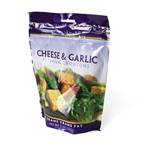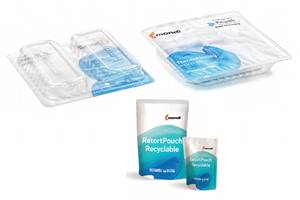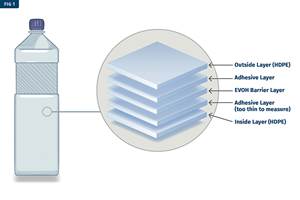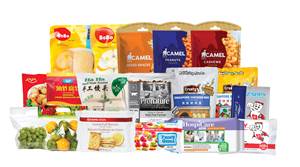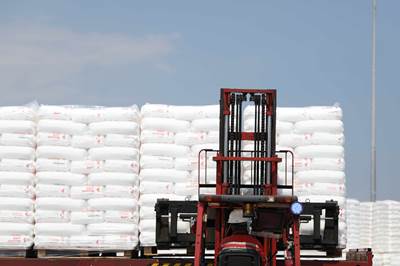Packaging Converter Adopts PE-Based Vacuum Skin Packaging (VSP) for Food Applications
Videplast and ExxonMobil collaborated on the development of this cost-effective VSP film solution that contains no ionomers.
Brazilian packaging converter Videplast worked with ExxonMobil to come up with a cost-effective and optimal vacuum skin packaging (VSP) product for a variety of food applications that offers reduced film thickness while still providing superior performance and containing no ionomers.
As a leader in Brazil’s packaging sector, Videplast’s diverse product portfolio encompasses stretch and shrink films, special heavy-duty bags and high-performance films tailored to meet a broad spectrum of packaging needs across multiple industries.
VSP combines a high-barrier thin film with a premade tray, with these components then sealed in a vacuum chamber. The vacuum softens the film, enabling it to conform to the shape of the tray and creating an airtight seal around the product. The VSP film encapsulates the food product and becomes like a second skin, eliminating almost all package atmosphere.
“We identified an opportunity in both the national and international markets to develop a differentiated structure for the VSP film,” says Leonardo Nunes da Silva, Videplast R&D Manager. “Furthermore, by creating a unique structure in the market that does not contain ionomers, we anticipated an opportunity for us to offer our customers a high-performance cost-effective solution.”

Videplast’s VSP film utilizing ExxonMobil’s Exceed LLDPE resin features optical properties that enable better product visibility. Source: ExxonMobil Chemical
According to the partners, this technology has been growing in recent years and is trending up in the near future, mainly due to the greater number of people living alone or in smaller families. As a result, there is a greater desire for smaller portions and single-serve packaging for goods like meat, cheese, fish and seafood, which require high-performance and visually appealing packaging solutions.
Videplast had previously produced a VSP with an ionomer-based solution, but it proved too expensive and was not commercialized. ExxonMobil provided Videplast with a proposed structure featuring its new performance LLDPE Exceed XP 7052ML, which offers multiple benefits. The seven-layer barrier film also included performance LLDPE Exceed XP 6056 as well as H-EVA and EVOH, resulting in a high-quality, durable film with excellent barrier properties.
The potential for significant cost savings by reducing film thickness and eliminating the use of ionomers is a key benefit. Videplast sees the opportunity for a 20% thickness reduction. In its first demonstration, the company is using PET trays (though cardboard and EPS trays were also under evaluation), with practical tests on meats and cheeses underway.
In addition to being easy to process, this film structure boasts enhanced protection from food spoilage, leakage and contamination, ensuring product safety and quality. Moreover, by removing air and providing a tight seal, the packaging extends the shelf life of perishable goods. The tight seal created by the packaging also helps prevent freezer burn, while outstanding optical properties enable better product visibility and improved aesthetics in vertical displays.
Videplast manufactures the VSP film utilizing advanced processing techniques to ensure optimal performance and consistency in the final product. The vacuum pack process involves optimal thermoformability and a high oxygen barrier, ensuring effective vacuum sealing and extended freshness.
Noting that the collaboration with ExxonMobil was key, Leandro Barcarolo Martinoto, R&D manager says, “Our motto is ‘Engagement makes the difference.’ The progress achieved in the VSP project generates high expectations. The implementation of VSP has the potential to generate substantial long-term savings. We are convinced of the positive impact that VSP will bring to our operations, expanding into new export markets, discovering innovative applications and optimizing operational costs.”
Related Content
In Sustainable Packaging, the Word is ‘Monomaterial’
In both flexible and rigid packaging, the trend is to replace multimaterial laminates, coextrusions and “composites” with single-material structures, usually based on PE or PP. Nonpackaging applications are following suit.
Read MoreFor Extrusion and Injection-Blow Molders, Numerous Upgrades in Machines and Services
Uniloy is revising its machinery lines across the board and strengthening after-sales services in tooling maintenance, spare parts and tech service.
Read MoreMeasuring Multilayer Plastic Containers Made Easier With Today's Ultrasonic Gauges
Ultrasonic gauge technology has evolved to simplify measurement of very thin layers in plastic containers. Today’s gauges with high-frequency capabilities and specialized software can make multilayer container measurement quick and easy for ordinary users.
Read MoreFlexible-Film Processor Optimizes All-PE Food Packaging
Tobe Packaging’s breakthrough was to create its Ecolefin PE multilayer film that could be applied with a specialized barrier coating.
Read MoreRead Next
High-Performance LLDPE Film Grades
ExxonMobil’s new series Exceed XP 7 hexene LLDPE resins boast “never seen before” levels of performance.
Read MoreNew Family of High-Performancen Packaging LLDPE-Like Resins
Dow's just announced Innate Precision Packaging Resins boast unmatched abuse resistance and excellent processability.
Read More


